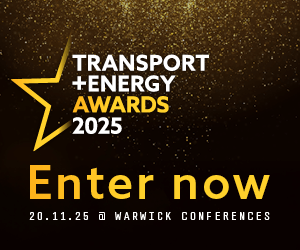Simon Pickett, EV Project Development Manager at SSE Enterprise, reflects on his time spent working across both the transport and energy sectors and how together they can offer a fast track route to zero carbon.
The world is changing for the better and its not as complicated, daunting or expensive as it first appears. Well, that is the view that I hold when looking at the challenge of electrifying fleets. Change is scary – that is the default position for many and it’s something that historically has been a blocker to innovation and positive business change. I see things differently and here is why.
Having lived and worked in the energy sector for over eight years I’ve seen some fairly significant change. The “big six” have now been disrupted and the domestic market is awash with startups looking to keep that disruption going. New suppliers have helped to challenge the notion that clients simply remain with the same company and roll on forever with a standard variable tariff. This change has helped to kick start the green revolution and pushed forward the smart and digital agenda. You can now sign up to a variety of switching sites that will keep you on the cheapest energy deal, whilst holding onto a renewable/green energy source*[1]. I would suggest energy will continue to get cleaner, become more locally generated and could also become far cheaper. Overall, consumer choice has increased, carbon footprints are shrinking, engagement with the energy sector has arguably improved and thus things are heading in the right direction. Organisations like mine (SSE plc) are already pushing on with significant green investments[2] from the largest offshore wind farm in the UK to Europe’s largest new pumped storage project and of course EVs.
How about fleets? The fleet sector has been evolving in this direction for years already and it can be seen as a critical enabler in the green revolution. Technological developments such as data loggers and route planning have been driving efficiency improvements for years. AI is coming into the picture in the form of autonomous vehicles as well as data lakes and machine learning. Vehicles can be updated over the air and drivers are warned of safety risks through their satnav and speakers. I would argue that transport in general is getting easier, safer, slicker and all those benefits will be captured, developed and boosted by fleets; the rewards are there. It’s also worth noting that fleets are a key driver in the second-hand vehicle market and just like energy multiple layers of stakeholders can benefit from that initial change.
Electrification of fleets
The electrification of fleets is happening, be it at an Optimise Prime scale[3] involving major corporates and thousands of vehicles or at a man in a van and small company director level; lessons have already been learned by many and first mover advantage will give some benefit to those early adopters. The fact that the energy regulator is funding a project such as Optimise Prime highlights the inevitable intersection of the fleet sector with the energy sector. What is interesting however, is that all types of business face the same questions – What will it cost? What will change in real terms? Is now the right time to make the switch? How complicated is it? As with anything, a good bit of research and a logical approach to the challenge will quickly yield good results and arguably the answers to almost all the above questions are positive.
The picture looks good. Costs are coming down based on TCO models and various changes such as cleaner depots, smoother and safe driving experiences, less time off the road for servicing, better efficiency in terms of fuel usage can all be found through EVs. The right time to switch is not quite as simple and there are long waits on some vehicles, furthermore a wider range of higher payload vehicles still need to appear (they are coming).
As for the complexity of the transition, it can be as complex or as simple as you decide to make it. Operationally, vehicles will typically still have the same functions, just the fuelling cycle and process is different. It is not currently as quick to charge a car or van as it is to fill up with petrol or diesel, however most fleets don’t have liquid fuelling options on depot sites or at home but most do have an electricity contracts and several options in relation to electrical installations; therefore it is just a matter of scale and time. In some cases, prior installations of solar make things even more interesting. SSE Enterprise and other forward-facing businesses are looking to deploy Ultra-rapid EV charging hubs across the country to support this transition, to enable fleets to make this switch and to connect wider distributed energy solutions for multiple benefits.
Working together
The reality of the energy sector coming into direct contact with the fleet and transport sectors is that the two are very well aligned; things can only get better as technology improves. Road networks and grid infrastructure are both seeing increasing use of smart technologies and data and what’s more, they can both support each other in doing this where electrical networks are directly connected to vehicle energy demands through smart platforms. Although technology is changing, fleets will not necessarily have to make fundamental changes to the ways they operate, just to find ways to factor in the benefits offered with far more convenient fuelling options. Furthermore, fleet expenditure on fuel is a massive revenue opportunity for the energy sector and renewable energy technologies present a huge opportunity for the fleet sector to drive down their costs and simultaneously take direct control of their own fuelling.
In summary, fleet electrification can help fund the modernisation of our electrical networks whilst boosting the energy sectors drive to net zero. Together, they can offer a fast track route to zero carbon. Vehicles will still be fuelled but the fuel will change. I would argue that the future is getting brighter and better and that the sooner these major parts of our economy come together, the quicker we can all realise the benefits.
If you have any comments or questions, please contact me or my colleagues at SSE Enterprise.
References:
[1] It should be noted that all energy comes through the same distribution network/grid and thus the fuel mix received is always a mix of the current generation. You can easily check this using the National Grid ESO app; https://play.google.com/store/apps/details?id=com.carbonintensityapp&hl=en_GB&gl=US 100% green energy supply is secured at source to ensure demand is matched with sustainable grid supply.
[2] The SSE Greenprint is supporting over £7.5b in green recovery investments; https://www.sse.com/news-and-views/2020/05/a-greenprint-for-a-cleaner-resilient-economy/
[3] https://www.optimise-prime.com/ – this is the worlds largest commercial EV project and involves a number of key parties including the DNOs, large fleet operators and the energy regulator Ofgem.















